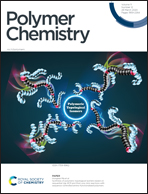Sequence-defined nucleobase containing oligomers via reversible addition–fragmentation chain transfer single monomer addition†
Abstract
Discovery of the intricate structure of self-assembled DNA has spurred an enormous research interest and inspired attempts to harness the properties of this fascinating biopolymer in synthetic analogs. Transferring the complementary hydrogen bonding characteristic of DNA and RNA nucleobases to synthetic polymers gives access to selective, dynamic behavior for unique materials properties. Adenine (A), thymine (T), uracil (U), cytosine (C) and guanine (G) derivatives of acrylic monomers were synthesized and used in reversible addition–fragmentation chain transfer (RAFT) single monomer addition. Consecutive RAFT reactions with intermediate purification via flash chromatography enabled the preparation of multiple-hydrogen bond sequence-defined (MHB SD) oligomers. Optimized flash conditions were established by separating different insertion products of an oligomer mixture with 0–5 uracil-based monomer repeating units. These separation conditions were applied in successive RAFT polymerizations resulting in three MHB SD tetramers with sequences AAAA, ACAC and finally ACTG, the latter of which contains all four distinct DNA nucleobase derivatives. This approach offers complete freedom of the desired short nucleobase sequence where the selective hydrogen bonding is appealing for applications ranging from biosensors to polymer–DNA conjugates, adhesives or self-healing materials.



 Please wait while we load your content...
Please wait while we load your content...